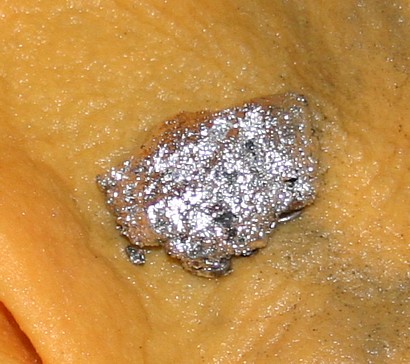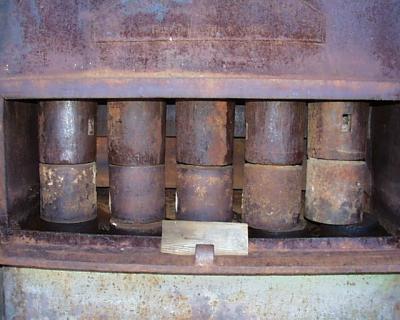Table of Contents
The earliest machines used for the purpose seem to have been stone mortars, in which the gold quartz was crushed by stone-hammers, or by large rocks raised by levers and let fall, whilst the fine material was subsequently washed out with water. The heavy particles of gold then settled to the bottom of the mortar, the lighter worthless material being washed away. The ore was first reduced to coarse powder in mortars, then finely crushed in hand-mills resembling the flour-mills of the present day, and finally washed. In order to separate the pulp from the uncrushed lumps, the Egyptians, in common with other races in ancient times, employed sieves, but in extracting the gold from auriferous sands they used raw hides, on which the flakes of gold were entangled. These devices closely resemble those still in use in many parts of the world.
The date of the first use of mercury for amalgamation is unknown, but it has no doubt been used for this purpose for the last 2,000 years. The earliest mention of quicksilver itself appears to occur in the works of Theophrastus, about B.C. 300; but Diodorus, in the account just mentioned, does not refer to its use. Only a few years later, however, Vitruvius, about B.C. 13, described the manner in which, by the help of mercury, gold was recovered from cloth in which it had been interwoven, and in Pliny’s time the separation of gold from its impurities generally by the same means was well-known. It is probable that this knowledge was never afterwards entirely lost, although the references to it in the Middle Ages are very scanty. For example, Geber, in the eighth century, was aware that mercury would dissolve considerable quantities of gold and silver, but not earthy materials, and Theophilus, the monk, in the eleventh century, carefully described the method of washing the sands of the Rhine on wooden tables, the final operation consisting in treating the concentrates with quicksilver for the removal of the gold. The extraction of gold by mercury is described by Biringuccio in his treatise (which was published in Italian in 1540), and had apparently been a secret art for some time previously.
Among other ancient methods of amalgamating ores, the tina and cazo systems may be mentioned. In Norway and Chili, however, the working was not continuous. Charges of crushed ore were introduced into wooden tubs (tinas) furnished with cast-iron bottoms and stirred up with water and mercury by means of revolving iron agitators, comparable to the mullers of the modern amalgamating pan. At Kongsberg only 80 to 100 lbs. of ore were treated at one time with about 40 lbs. of mercury, but in Chili a tina contained from 4 to 6 cwts. of ore and 150 lbs. of mercury or more. After the agitators had been at work for about four hours, making sixteen revolutions per minute, the mercury was drawn off, squeezed through calf-skin or canvas bags, and the amalgam removed from the bags and retorted. The cazo process, introduced in Peru, was similar, but the bottom of the vessel was of copper and the pulp was boiled. These processes were used in treating ores rich in silver.
Amalgamation Plates
These plates are usually made of copper, and are as much as 3/8 inch thick for the inside of the battery and 1/16 to 3/16 inch thick for the outside. The average weight used in California is 3 lbs. per square foot. It was formerly laid down as a general rule that the heaviest plates were the best, as they last longer and are not so easily dented, but comparatively light plates are now used. The copper should be of the best quality, and, if it is hard, it must be annealed before applying the mercury, so as to make it absorbent. This was formerly done by heating it from below as uniformly as possible until sawdust laid on the upper surface was ignited. The plate is then straightened by blows of a wooden mallet, striking a block of wood laid on it, and the surface is carefully cleaned by scouring with sand or fine emery paper until quite bright, and washed with strong soda to remove all traces of grease. Cleaning may also be affected by nitric acid diluted with 9 parts of water, or by a 2½ per cent, solution of potassium cyanide, rubbed on with a woollen rag and carefully washed off with water. As soon as the plate is clean, it is rubbed with a mixture of fine sand, sal-ammoniac and mercury by means of a brush, the sal-ammoniac preventing the recommencement of oxidation. Potassium cyanide is now more often used than sal-ammoniac, and the sand is sometimes omitted. More mercury is sprinkled on and wiped over with the brush or a piece of rubber until the surface is pasty. Care is taken not to make the plate “ wet ” with mercury. If any drops of mercury appear on the plate losses occur through scouring.
If the plates were used in this condition they would not catch the gold very well at first, but would continually improve until they had become coated with gold amalgam. In order to make them efficient from the start, they are usually coated with gold amalgam or silver amalgam before being laid down in the mill. Gold amalgam is most effective but is seldom used, as it is so much more expensive than silver. The amalgam is rubbed on with a piece of india-rubber, the plate being wetted with a solution of sal-ammoniac or potassium cyanide to keep it bright. The whole operation is called setting the plates. According to Roskelley 16 ozs. of mercury and 6 ozs. of gold amalgam are enough for setting a plate 16 feet by 4 feet 9 inches. A more usual method of preparing the plates in California is to coat them with electro-deposited silver. This plating is done by certain establishments in California for most of the mills, but it can be done on the spot without much difficulty, the plant required being inexpensive. After being silvered, the plates have the mercury applied to them. They absorb a large amount of mercury, catch gold well, and are little trouble to keep clean. The plates need not be re-silvered, except after scraping and sweating (see under “ The Clean-up,” Chap. vii.), as they become coated with gold amalgam in the course of time. About 1 oz. of electro-deposited silver is required per square foot of copper plate. Silvered plates are not used inside the mortar.
How to Install Amalgamation Plates & How Amalgamatiing Plates Work
The lower edges of the inside plates are level with the upper surface of the pulp, when the battery is working properly—i.e., they are usually at 1½ or 2 inches above the surface of the dies. The plate on the feed side is generally about 9 to 12 inches wide, and is of the same length as the battery ; it is bolted to the mortar itself, and its angle of inclination varies with the shape of the latter, so that the angle of inclination is sometimes 40°, and it is sometimes nearly vertical. The plate on the discharge side is inclined at an angle of 10° to 50° to the vertical, and is as wide as the space below the screen permits, being usually from 3 to 6 inches wide. Sometimes the plate is curved to fit the chuck-block and sometimes it is bent. It is fixed to a wooden chuck-block, which has its top bevelled off so as not to obstruct the screen opening. The block is bolted to the mortar with some thickness of blanketing between, in order to make a tight joint. Several sizes of these chuck-blocks, with their copper plates attached, are kept in one and the same mill, a wider block being substituted for a narrower one when the wear of the dies has proceeded to a certain extent.
At the Alaska Treadwell Mill, and at one or two mills on the Rand, the cast-steel linings of the mortars were furnished with several horizontal slots or recesses for the collection of amalgam, and these took the place of the back copper plates. The front or chuck-plate was, however, retained in these mortars. This arrangement is shown in Fig. 29. Inside plates are now generally discarded on the Rand.
The outside plates are fastened to a wooden table with copper nails, or wooden clamps, or by wedges driven into the raised edges of the table. The table is as wide as the battery (4 feet 9 inches) and usually from 6 to 8 feet long. On the Rand they are 12 to 16 feet long. In California a length of 2 or 3 feet of plates of the same width, the apron plates, are interposed between the battery and the tables proper, on to which there is a drop of 2 or 3 inches. Below the tables there is a succession of four or five sluice plates, each about 30 inches long, with drops of 1 to 3 inches between them. They are usually made narrower than the others, and are frequently only 12 or 18 inches wide. This practice is doubtless due to the traditions as to the treatment of auriferous gravel in sluice boxes existing when amalgamated plates were first devised and introduced. It is not to be commended, as the stream of ore and water, forced into a narrower channel, becomes deeper and flows more rapidly and tumultuously, with the result that the contact between the ore and amalgamated plates is much reduced, and very little gold is caught. The use of the drops is to assist in catching the float gold and to separate the amalgam which has become floured and mixed with the pulp. In place of the composite arrangement described above, a single length of 12 or 14 feet of plates is often used, especially in the Transvaal, but it is usual in this case for a plate about 14 inches wide to be placed at the lip of the mortar, resting on the lower bar of the screen frame. This plate corresponds to the apron plates.
To aid in catching the float gold, swinging amalgamated plates have been introduced, and are in use in the sluices below the batteries of many Californian mills. They are also used in hydraulic mining. The swinging plate consists of a curved strip of silver-plated amalgamated plate about 3 inches deep, and of the same width as the sluice in which it is hung; it is suspended on eyes through which wires pass. The plate thus hangs, half submerged, with its concave side up-stream, and is kept swinging by the current, so that all floating particles of gold must come in contact with it. It is found in practice that, immediately under each plate, across the sluice, a line of amalgam which has dropped from the plate accumulates. The plates are placed a few feet apart. They cost little and are very effective.
